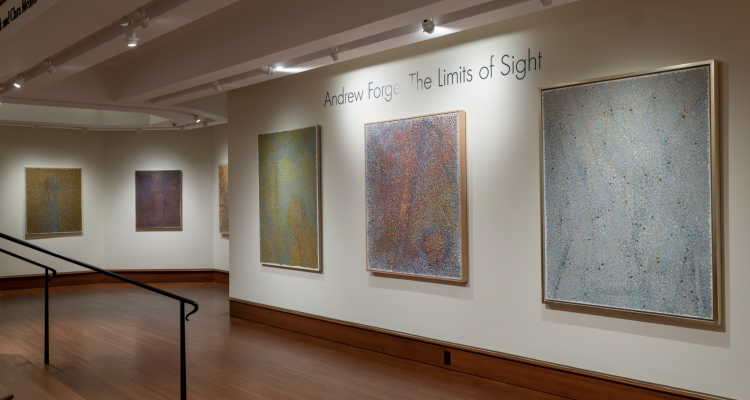This week I had the pleasure of attending the exhibit “Andrew Forge: The Limits of Sight,” held in the Fairfield University Art Museum. Andrew Forge was a British artist and professor at Yale University, who, from 1975 to 1994, served as the dean of the Yale University School of Art. I attended the exhibit with my figure drawing class, taught by Suzanne Chamlin-Richer of the studio art department, who was taught by Forge in graduate school. The museum’s executive director, Carey Weber said that “this is the first museum exhibition of Forge’s work in Fairfield County and only the second since his death in 2002. We are honored to present these sublime works.”
My class visited with the intention to not just look, but to draw as well. We were instructed to choose one of the paintings and then recreate it in our sketchbooks with a pencil. We were also given the option to either keep our recreations as pencil drawings or to add watercolor or gouache paint to them, and mirror Forge’s exhibit.
At first glance, this task seemed daunting. The pieces are paintings made up of large amounts of multi-colored dots, some of which include other figures, such as lines and rectangles. We were not allowed to bring paint into the museum, so as not to accidentally ruin a painting, so we were told to sit down in front of a painting of our choosing with a sketchbook and pencil, and draw until our time in the exhibit was over. How was I supposed to recreate a thousand colorful dots in a pencil sketch? By drawing a thousand tiny circles with my pencil, or maybe tapping my pencil on the paper a thousand times? Surely, these methods could not capture the image of thousands of randomly-placed colorful spots.
I strolled through the exhibit, trying to pick out a painting that I had the capability of capturing on my sketchpad. Each piece seemed more difficult than the last. Finally, upon closer inspection, I realized that the dots were not random at all, but instead created patterns and shapes that were even more apparent if one stood further away from the painting. One painting first appeared to be layers and layers of mostly green and blue dots, but was then revealed to contain a large triangle in the center, along with some other angular lines. Another piece seemed to be a myriad of blue and orange dots, but once looked at with a more focused observation, it revealed a figure that looked almost like a doorway or window into another world. I found that the longer I stared at a painting, the more figures seemed to appear, as if I were staring at a magic-eye puzzle. It was at this moment that I realized I would not have to spend the rest of the class period drawing countless tiny circles on a piece of paper in my sketchbook, and could instead draw the less-obvious shapes hidden in the paintings.
At last, I chose a subject for my drawing: a painting consisting of mainly pale yellow and blue dots, which when inspected more thoroughly appeared to have intersecting lines scattered across the canvas, and also sparsely placed dark green dots that resembled constellations one might see in the night sky. I sat down with my sketchpad, pencil in hand, copying the lines and clusters of green specks as closely as I could into my sketchbook, planning to add color to them later when I was no longer at risk of accidentally vandalizing the museum’s artwork.
Art pieces like the ones shown in this exhibit, which are abstract and do not depict real-life objects, are often dismissed as not being real art, or being something that a child could create. To many, an art piece not based in realism is seen as pointless or not requiring skill. On the contrary, abstract art often has a lot of thought put into it and can be seen as an exploration of things such as shape, line, form or color. Not being able to use color in the beginning stages of my painting turned out to be to my benefit, as it forced me to analyze the paintings more deeply and truly appreciate the shapes and figures that were not obvious at first glance. This allowed me to really acknowledge the planning, hard work and strategy that went into Forge’s paintings.


Leave a Reply